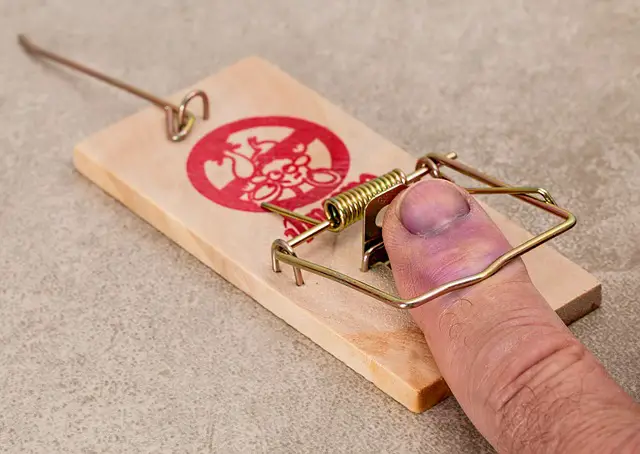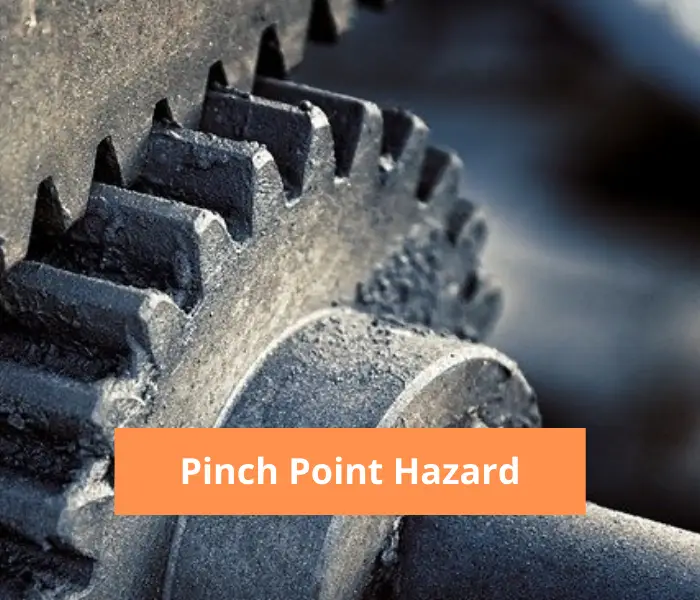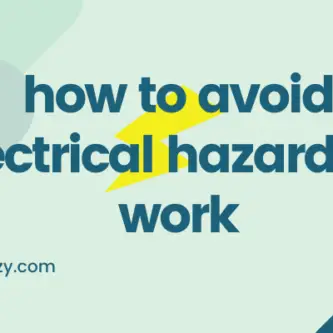It was a normal day at my office. But, later it ended by being sick in the bed.
I’m an electrical engineer, I was in my office with another person. I found a mechanical mechanism of a circuit breaker.
I hold it with my right hand, and I pushed a button. That’s all!
The mechanism was activated and my thumb was pinched so hard that I couldn’t remove it or move the mechanism.
I was surprised and even couldn’t scream or ask for help. All I did, I looked at my pinched thumb, neither I rescued my self, nor I asked for help.
Lucky for me, the other person, who was with me, noticed me. He tried his best to get my thumb out, fortunately he did it. It was so hard to open the mechanism a little enough!
After that, I was about to loses consciousness. And I went to the clinic. And spent my day in bed.
From this true story, that happened to me, I can say, pinch point may be really closer than you think!
What is Pinch Point?
The term “Pinch Point” refers to any place where a body part might get trapped between moving and stationary parts of a machine or piece of equipment. Pinch point is a mechanical hazard.
Although these “pinching” points may sound unappealing, they actually are.
A pinch point can be anything from a finger trapped, like what happened to me, in a conveyor belt to becoming caught between moving and stationary elements of a machine.
Injuries such as fractures, amputations, and even death are possible if a person or bodily part is in that area during the pinching process.
Warehouses are designed with a variety of job risks. Sharp corners, ladders that are too high, forklifts, etc. are all hazards. The list goes on.
All of these, and more, can lead to significant workplace injuries and put employees at risk of serious harm.
There are certain situations in which a person or part of their body might get caught between moving elements in a machine that are not considered by most people.
Where are pinch points found?
Almost all workplaces have pinch point hazard. It also can be found in construction sites, offices, homes and you car, like car door.
pinch points in construction
Pinch point is a common risk in construction sites because, heavy trucks, heavy weights moving belts, hand tools and other sources of the pinch point.
To control pinch point in construction sites:
- Verify all workers wear PPE
- Signs and warnings should be used to verify every one is aware of the hazard.
- Workers should only enter areas they are allowed to enter.
- Moving machines require good trained workers only.
- Verify visitors are kept safe and wear PPE.
- All trucks should have working backup alarms and lighting.
- Use guarding in places effectively.
For more information read my article electrical safety in construction sites.
pinch point hazard examples
- In between the handles and the box shapes, the fingers and hands were squeezed.
- Rolling or moving pipes cause fingers and hands to be pinched.
- Performing maintenance, cleaning, or other tasks using spinning machinery
- Inappropriate hand tool selection.
- A pallet, a ring, or a header hooked with your hand.
- By the counterbalance or body of a forklift in motion
- When a crane releases a cargo, a hand is placed in the line of fire.
- Struck between a wall and a backing up truck; no serious injuries.
As a result of these ubiquitous pinch point concerns, warehouse personnel and others working in industrial settings are at significant risk.
Equipment With Pinch Point Hazard
- Power presses
- conveyors
- robots
- metal-forming machines
- assembly machines and lines
- printing presses
- Heavy material
- electrical generators
Are only few examples of the equipment and gadgets that might cause them. Even doors, coverings, and hatches that you would assume are safe might trap someone.
is a hammer handle a pinch point?
Yep, hammers is a hazard that has pinch point risk. Hammer is a moving part, your finger on a table or any stationary object, the hammer can crush your finger or hand. This is typically the pinch point risk.
Hammers are light or heavy weight, the heavier the hammer the higher risk it can cause.
Wear proper gloves when using hammers to reduce the pinch point risk.
Is a door a pinch point?
All types of doors, windows and gates can cause a pinch point, specially to children.
I can remember, when I was a child, my grandma movement was slow enough. Once, the door closed before she get her fingers away.
Of course here finger got hurt, because of the door is a pinch point.
Now, I always take care of my kids, and teach them not to put their fingers on the way of the door closing, or just behind the door when it is opened.
Types of Pinch Points injuries
Amputations, lacerations, contusions, crushing of tissues and bones, and fractured bones are examples of pinch point injuries.
What is Dangerous About Pinch Point
Amputations, lacerations, contusions, crushing of tissues and bones, and shattered bones are among the injuries that can be caused by pinch points.
Once you’re caught at a pinch point, you can’t escape because rotating mechanical parts are moving too quickly. So all moving portions of belt and pulley drives that are seven feet or less above the floor must be protected with safety guards or shields.
In this hazard, one or more items move towards each other, crushing or shredding anything in their path. Machines include conveyors, gears, loaders, compactors, and other moving equipment.
Causes Of this Hazard
Below are some of the factors that might cause a pinch to occur:
- Hands and feet not being properly positioned
- The use of mobile equipment and permanent structures while walking or working
- Rotating components and equipment might snag clothes, hair, or jewellery.
- Inadequate equipment and guarding conditions
- Materials or hanging loads are dropped or handled recklessly.
- Work processes or tools are not followed properly.
- Reaching inside equipment and machinery that is in motion
Important Considerations
When two items collide, a pinch point is created, and a person might be caught or harmed if they come into touch with it.
The most frequent location of contact for pinch points is the fingers and hands, however they can affect any part of the body.
Puncture wounds can range from small blisters up to amputation and even death. Moving equipment such as conveyors, gearboxes, loaders, compactors, etc., have pinch points.
From the office, like what happened to me, to an offshore platform, pinch points can arise in any type of workplace or profession.
Doorways and crane outriggers can be pinch points. Vehicle doors, cabinet doors, rolling pipe, and goods being unloaded/loaded have all caused injuries.
Safety Measures and Hazard Control

Accidents involving pinch points can be prevented. If you stay focused on the work and the probable repercussions of your actions, you can avoid getting “bit”. What follows are a few helpful safety measures:
- Maintain a clean and tidy workplace by following excellent housekeeping practices.
- Gloves should be worn. There’s a chance that wearing them around moving machinery might be dangerous.
- Machine guards should not be tampered with. They’re there to keep you safe.
- So that materials cannot fall or roll, secure them. Materials that are stacked should be fastened together.
- The use of doorknobs and drawer handles can help you avoid smashing your finger into something.
- In your work environment, be mindful of pinch points, such as those connected with equipment or machinery that you may use and/or operate with and/or close to.
- Assure that all equipment and machinery pinch point covers and shields are in place.
- Clothing, jewellery, and hair that is too loose might be snagged. Before working near pinch point risks, wear tightened clothes, remove jewellery, and tie long hair back or put it beneath a hat.
- Adhere to pinch point dangers with warning labels and keep them in place.
- Mechanical parts that are in motion should never have hands put near them or across them.
- Keep your fingers, hands, toes or feet away from any sharp edges or protrusions when you position them between items.
- Operating equipment or machinery without the proper safety devices is prohibited
- Before doing maintenance or repairs, turn off and de-energize equipment or machinery. Follow lockout/tagout procedures as necessary
- After performing maintenance or repairs on equipment and machinery, replace guards or shields.
- Pinch point risks can be identified by pre-work inspections. These dangers can be controlled using the techniques mentioned below, in accordance with the hierarchy of hazards.
- The pinch point is physically prevented from being entered by engineering controls.
- Barriers and machine guards are used to keep people and machines safe.
- To prevent pinch points, workers are guided by administrative controls.
- Work procedures, instructions and operational manuals should be followed, as well as proper training.
- By preventing things from being pinched, personal protective equipment protects persons exposed to the threat.
Pinch point injuries can be prevented with the right control efforts Employees, supervisors, and safety engineers will need to work their way up the Hierarchy of Hazard Controls to evaluate whether the pinch point hazard can be entirely removed or whether it can be replaced with something less hazardous.
The following controls will need to be considered if any of these alternatives is not possible.:
-
Engineering Controls:
Engineering controls such as machine guards protect workers from coming into touch with dangers.
Hands and limbs can be entirely protected against pinch points by installing physical guards around the dangerous locations.
A gadget is a different sort of guard. When someone or anything gets too close to a machine’s pinch points, the machine will typically stop.
-
Administrative Controls:
By requiring pre-work inspections and risk assessment, employers guarantee that workers have identified all potential choke spots before ever starting the job.
Workers should also be trained (and re-trained) on safe operating practices.
Read Also my article about What is Risk Assessment? And How To Perform it? for more information.
-
Personal Protective Equipment (PPE)
The worker should be covered with the appropriate Personal Protective Equipment (PPE) whenever he or she comes into contact with the pinch point at any time during the day.
As far as safeguarding employees’ hands from nip points, safety gloves, forearm guards, and metacarpal guards are the most common alternatives.
Pinch Point Statistics
The hand is the second most commonly injured body component at work.
According to the Bureau of Labor Statistics, hand injuries accounted for roughly 14 percent of all injury cases in 2018.
Back injuries are the most common. Safety problems such as pinch point injuries, line of fire accidents, and crush points affect environmental services personnel every day, whether they’re working on a drilling platform, taking samples, or adding amendments.
They cost firms millions in insurance claims and might result in regulatory fines, as well as affecting their capacity to secure future employment. Employees who suffer these accidents may be left with long-term or even permanent effects.
These sorts of injuries can be prevented by using the precautions outlined in today’s blog post. According to current figures, 1 out of every 20,000 employees will suffer an amputation at work.
In industries such as manufacturing, construction, and agriculture, amputation injuries occur more often, with an average of around 1.6 per 10,000 employees.
In manufacturing, amputation rates are on the rise, despite an overall decline in occupational injuries over time. Each year, 57 percent of workers are amputated in just one business alone.
OSHA Pinch Point requirements
Employers should thoroughly assess all apparatus and equipment in the workplace to prevent workers from suffering from these issues and injuries.
As a result, leaders will be able to identify problem areas and implement safety measures to decrease incidents.
OSHA advises installing guards to avoid employee contact with pinch points.
It is possible to prevent employees from becoming injured by placing guards at pinch points so that they do not reach through, over, under, or around these areas.
Employers must educate and teach personnel on the purpose of the guards and why machinery and equipment need them once the appropriate guarding has been installed.
When a body part is caught at a pinch point, it might result in workplace injuries.
Pinch points are places on the body where a body component might become stuck.:
- Within the confines of machine parts in motion
- Machine parts that are in motion and those that are in motion
- There are many moving parts and materials that must be processed or produced.
Examples of other pinch point scenarios that are not covered by OSHA standards include:
- Failing to avoid trapping your hands or feet beneath or in between large containers or equipment while you move them.
- Fingers or hands slamming into a door
- Using hand tools such as pliers to nip fingers or hands.
- Equipment with sliding components or hinges can nip fingers or hands.
- Fingers or hands getting pinched while sealing a container
- Assembling clothes or jewellery that gets caught in an awkward position



